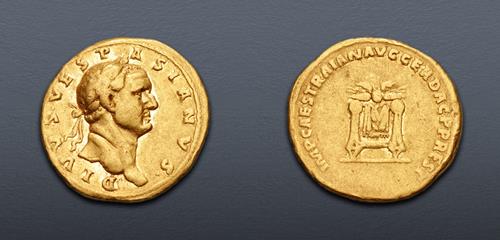
|
Divus Vespasian. Died AD 79. AV Aureus (19mm, 6.96 g, 7h). Restitution issue. Rome mint. Struck under Trajan, circa AD 107 or 112/113.
Triton XXV
Lot: 844. Estimated: $ 7 500
Roman Imperial, Coin-in-Hand Video, Gold
Sold For $ 8 000. This amount does not include the buyer’s fee.
Go to Live
|
|
Divus Vespasian. Died AD 79. AV Aureus (19mm, 6.96 g, 7h). Restitution issue. Rome mint. Struck under Trajan, circa AD 107 or 112/113. DIVVS • VESPASIANVS •, laureate head right / IMP CAES TRAIAN AVG GER DAC P P REST, pulvinar (throne) of Jupiter and Juno: square seat, draped, surmounted by horizontal winged thunderbolt. RIC II 829 (Trajan); Woytek 8662 (this coin); Komnick Type 67.0, 11 (V3/R3 – this coin); Calicó 707; BMCRE 703 (Trajan); BN 482 (Trajan); Biaggi 353. Underlying luster, a few minor marks. Near VF. Rare.
Ex Triton X (9 January 2007), lot 600; Sternberg XI (20 November 1981), lot 609.
Although several Roman emperors re-issued types struck by their predecessors, which modern numismatists call restitution coinage, such coinage of Trajan is somewhat of an enigma. Unlike his Julio-Claudian and Flavian predecessors, whose restitution series was limited to bronze issues of specific emperors, Trajan struck only aurei and denarii. Issues of certain previous emperors, including Trajan’s immediate predecessor Nerva, as well as certain Republican issues, such as an early didrachm that had been long out of circulation. In general, the striking of restitution coinage was meant to legitimize the new regime in the eyes of the populace through an expression of pietas to the “good” emperors who deserved to be remembered, as was the case of the Flavians, who included bronze coins of Galba, while omitting Caligula, Nero, Otho, and Vitellius (see BMC II, p. lxxviii). In the case of Trajan’s restitution issues, however, legitimacy appears not to be the sole reason, since he had been appointed to succeed Nerva prior to the latter’s death and was thus Nerva’s legitimate successor.
Relative to dating Trajan’s restitution coins, the traditional dating of AD 107 is based on Eckhel’s theory linking the restitution coinage with the general recoinage that Dio places after Trajan’s return from the Second Dacian War. Bernhard Woytek disagrees, and places their issue in AD 112/113, surmising that the appearance of Divus Nerva in this coinage must be contemporary to his appearance on an aureus securely dated to that period. Curtis Clay, however, pleads for the traditional dating of recoinage which, according to Dio, began circa AD 107. He states that “If the restored coinage was connected with the recoinage, and the recoinage began circa AD 107, how likely is it that Trajan would have waited until AD 112-3 to issue the restored coins resulting from that recoinage?”
Only with further study of the coinage itself might the purpose of Trajan’s restitution coinage be fully understood.
The final winners of all Triton XXV lots will be determined at the live public sale that will be held on 11-12 January 2022. Triton XXV – Session Three – Roman Republican & Imperatorial Coinage through Byzantine Coinage will be held Wednesday morning, 12 January 2022 beginning at 9:00 AM ET.
Winning bids are subject to a 20% buyer's fee for bids placed on this website and 22.50% for all others.
We recognize that our users may have various Internet Browsers and Operating Systems. We like our visitors to have the best possible experience when using our bidding platform. However, we do recognize that it is impossible to develop applications that work identically, efficiently and effectively on all web browsers. The CNG bidding platform supports the latest stable major version and the stable previous version of Mozilla Firefox and Chrome.
|
